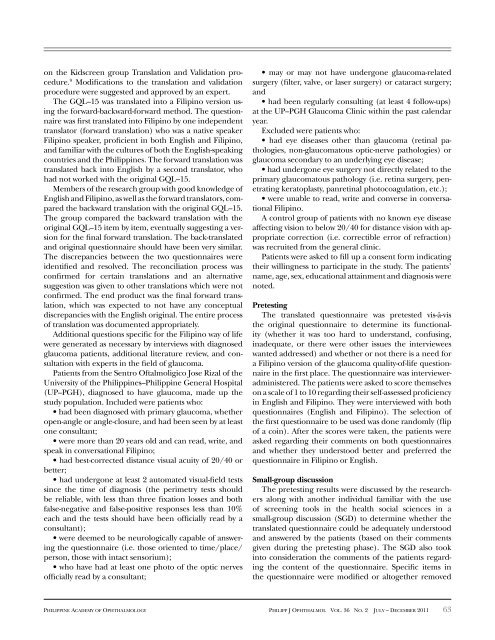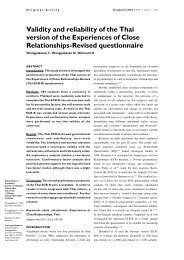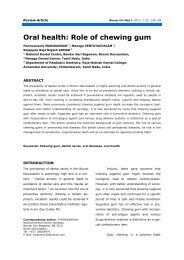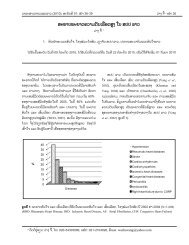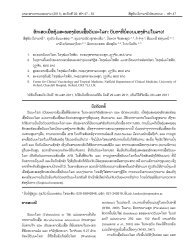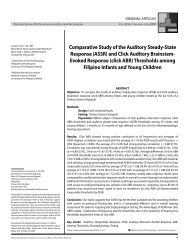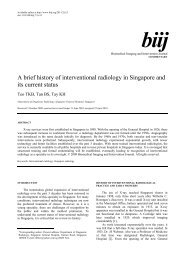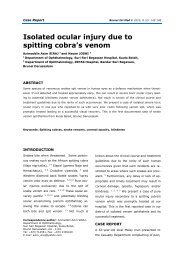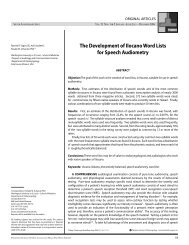Translation and validation of a Filipino version of the glaucoma ...
Translation and validation of a Filipino version of the glaucoma ...
Translation and validation of a Filipino version of the glaucoma ...
Create successful ePaper yourself
Turn your PDF publications into a flip-book with our unique Google optimized e-Paper software.
on <strong>the</strong> Kidscreen group <strong>Translation</strong> <strong>and</strong> Validation procedure.9 Modifications to <strong>the</strong> translation <strong>and</strong> <strong>validation</strong>procedure were suggested <strong>and</strong> approved by an expert.The GQL–15 was translated into a <strong>Filipino</strong> <strong>version</strong> using<strong>the</strong> forward-backward-forward method. The questionnairewas first translated into <strong>Filipino</strong> by one independenttranslator (forward translation) who was a native speaker<strong>Filipino</strong> speaker, pr<strong>of</strong>icient in both English <strong>and</strong> <strong>Filipino</strong>,<strong>and</strong> familiar with <strong>the</strong> cultures <strong>of</strong> both <strong>the</strong> English-speakingcountries <strong>and</strong> <strong>the</strong> Philippines. The forward translation wastranslated back into English by a second translator, whohad not worked with <strong>the</strong> original GQL–15.Members <strong>of</strong> <strong>the</strong> research group with good knowledge <strong>of</strong>English <strong>and</strong> <strong>Filipino</strong>, as well as <strong>the</strong> forward translators, compared<strong>the</strong> backward translation with <strong>the</strong> original GQL–15.The group compared <strong>the</strong> backward translation with <strong>the</strong>original GQL–15 item by item, eventually suggesting a <strong>version</strong>for <strong>the</strong> final forward translation. The back-translated<strong>and</strong> original questionnaire should have been very similar.The discrepancies between <strong>the</strong> two questionnaires wereidentified <strong>and</strong> resolved. The reconciliation process wasconfirmed for certain translations <strong>and</strong> an alternativesuggestion was given to o<strong>the</strong>r translations which were notconfirmed. The end product was <strong>the</strong> final forward translation,which was expected to not have any conceptualdiscrepancies with <strong>the</strong> English original. The entire process<strong>of</strong> translation was documented appropriately.Additional questions specific for <strong>the</strong> <strong>Filipino</strong> way <strong>of</strong> lifewere generated as necessary by interviews with diagnosed<strong>glaucoma</strong> patients, additional literature review, <strong>and</strong> consultationwith experts in <strong>the</strong> field <strong>of</strong> <strong>glaucoma</strong>.Patients from <strong>the</strong> Sentro Oftalmoligico Jose Rizal <strong>of</strong> <strong>the</strong>University <strong>of</strong> <strong>the</strong> Philippines–Philippine General Hospital(UP–PGH), diagnosed to have <strong>glaucoma</strong>, made up <strong>the</strong>study population. Included were patients who:• had been diagnosed with primary <strong>glaucoma</strong>, whe<strong>the</strong>ropen-angle or angle-closure, <strong>and</strong> had been seen by at leastone consultant;• were more than 20 years old <strong>and</strong> can read, write, <strong>and</strong>speak in conversational <strong>Filipino</strong>;• had best-corrected distance visual acuity <strong>of</strong> 20/40 orbetter;• had undergone at least 2 automated visual-field testssince <strong>the</strong> time <strong>of</strong> diagnosis (<strong>the</strong> perimetry tests shouldbe reliable, with less than three fixation losses <strong>and</strong> bothfalse-negative <strong>and</strong> false-positive responses less than 10%each <strong>and</strong> <strong>the</strong> tests should have been <strong>of</strong>ficially read by aconsultant);• were deemed to be neurologically capable <strong>of</strong> answering<strong>the</strong> questionnaire (i.e. those oriented to time/place/person, those with intact sensorium);• who have had at least one photo <strong>of</strong> <strong>the</strong> optic nerves<strong>of</strong>ficially read by a consultant;• may or may not have undergone <strong>glaucoma</strong>-relatedsurgery (filter, valve, or laser surgery) or cataract surgery;<strong>and</strong>• had been regularly consulting (at least 4 follow-ups)at <strong>the</strong> UP–PGH Glaucoma Clinic within <strong>the</strong> past calendaryear.Excluded were patients who:• had eye diseases o<strong>the</strong>r than <strong>glaucoma</strong> (retinal pathologies,non-<strong>glaucoma</strong>tous optic-nerve pathologies) or<strong>glaucoma</strong> secondary to an underlying eye disease;• had undergone eye surgery not directly related to <strong>the</strong>primary <strong>glaucoma</strong>tous pathology (i.e. retina surgery, penetratingkeratoplasty, panretinal photocoagulation, etc.);• were unable to read, write <strong>and</strong> converse in conversational<strong>Filipino</strong>.A control group <strong>of</strong> patients with no known eye diseaseaffecting vision to below 20/40 for distance vision with appropriatecorrection (i.e. correctible error <strong>of</strong> refraction)was recruited from <strong>the</strong> general clinic.Patients were asked to fill up a consent form indicating<strong>the</strong>ir willingness to participate in <strong>the</strong> study. The patients’name, age, sex, educational attainment <strong>and</strong> diagnosis werenoted.PretestingThe translated questionnaire was pretested vis-à-vis<strong>the</strong> original questionnaire to determine its functionality(whe<strong>the</strong>r it was too hard to underst<strong>and</strong>, confusing,inadequate, or <strong>the</strong>re were o<strong>the</strong>r issues <strong>the</strong> intervieweeswanted addressed) <strong>and</strong> whe<strong>the</strong>r or not <strong>the</strong>re is a need fora <strong>Filipino</strong> <strong>version</strong> <strong>of</strong> <strong>the</strong> <strong>glaucoma</strong> quality-<strong>of</strong>-life questionnairein <strong>the</strong> first place. The questionnaire was intervieweradministered.The patients were asked to score <strong>the</strong>mselveson a scale <strong>of</strong> 1 to 10 regarding <strong>the</strong>ir self-assessed pr<strong>of</strong>iciencyin English <strong>and</strong> <strong>Filipino</strong>. They were interviewed with bothquestionnaires (English <strong>and</strong> <strong>Filipino</strong>). The selection <strong>of</strong><strong>the</strong> first questionnaire to be used was done r<strong>and</strong>omly (flip<strong>of</strong> a coin). After <strong>the</strong> scores were taken, <strong>the</strong> patients wereasked regarding <strong>the</strong>ir comments on both questionnaires<strong>and</strong> whe<strong>the</strong>r <strong>the</strong>y understood better <strong>and</strong> preferred <strong>the</strong>questionnaire in <strong>Filipino</strong> or English.Small-group discussionThe pretesting results were discussed by <strong>the</strong> researchersalong with ano<strong>the</strong>r individual familiar with <strong>the</strong> use<strong>of</strong> screening tools in <strong>the</strong> health social sciences in asmall-group discussion (SGD) to determine whe<strong>the</strong>r <strong>the</strong>translated questionnaire could be adequately understood<strong>and</strong> answered by <strong>the</strong> patients (based on <strong>the</strong>ir commentsgiven during <strong>the</strong> pretesting phase). The SGD also tookinto consideration <strong>the</strong> comments <strong>of</strong> <strong>the</strong> patients regarding<strong>the</strong> content <strong>of</strong> <strong>the</strong> questionnaire. Specific items in<strong>the</strong> questionnaire were modified or altoge<strong>the</strong>r removedPhilippine Academy <strong>of</strong> Ophthalmology Philipp J Ophthalmol Vol. 36 No. 2 July – December 201163


